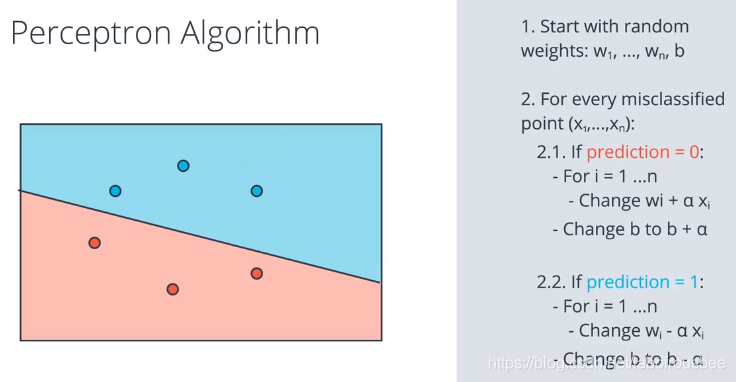版权声明:本文是原创文章,转载需注明出处。 https://blog.csdn.net/laboirousbee/article/details/88955962
目录
分类问题
神经网络是机器学习中的一个模型,可以用于两类问题的解答:
-
分类:把数据划分成不同的类别
-
回归:建立数据间的连续关系
什么是分类问题?分类(classification),即找一个函数判断输入数据所属的类别,可以是二类别问题(是/不是),也可以是多类别问题(在多个类别中判断输入数据具体属于哪一个类别)。与回归问题(regression)相比,分类问题的输出不再是连续值,而是离散值,用来指定其属于哪个类别。分类问题在现实中应用非常广泛,比如垃圾邮件识别,手写数字识别,人脸识别,语音识别等。

线性界线
W为权重,b为偏差。

更高维度的界线


感知器
多层感知器的结构,称之为神经网络。

用感知器实现简单逻辑运算
实现AND(与)、OR(或)、NOT(非),XOR(异或)。


感知器技巧——计算机如何“学习”分类
这个分类方法,个人感觉像绝对值误差方法。整个数据集中的每一个点都会把分类的结果提供给感知器(分类函数),并调整感知器。——这就是计算机在神经网络算法中,找寻最优感知器的原理。


感知器算法

感知器步骤如下所示。对于坐标轴为 (p,q)(p,q) 的点,标签 y,以及等式 \hat{y} = step(w_1x_1 + w_2x_2 + b)y^=step(w1x1+w2x2+b) 给出的预测
- 如果点分类正确,则什么也不做。
- 如果点分类为正,但是标签为负,则分别减去 \alpha p, \alpha q,αp,αq, 和 \alphaα 至 w_1, w_2,w1,w2, 和 bb
- 如果点分类为负,但是标签为正,则分别将 \alpha p, \alpha q,αp,αq, 和 \alphaα 加到 w_1, w_2,w1,w2, 和 bb 上。
import numpy as np
# Setting the random seed, feel free to change it and see different solutions.
np.random.seed(42)
def stepFunction(t):
if t >= 0:
return 1
return 0
def prediction(X, W, b):
return stepFunction((np.matmul(X,W)+b)[0])
# TODO: Fill in the code below to implement the perceptron trick.
# The function should receive as inputs the data X, the labels y,
# the weights W (as an array), and the bias b,
# update the weights and bias W, b, according to the perceptron algorithm,
# and return W and b.
def perceptronStep(X, y, W, b, learn_rate = 0.01):
# Fill in code
for i in range(len(X)):
y_hat = prediction(X[i], W, b)
if y[i] - y_hat == 1: #分类为负,标签为正
W[0] += X[i][0] * learn_rate
W[1] += X[i][1] * learn_rate
b += learn_rate
if y[i] - y_hat == -1:
W[0] -= X[i][0] * learn_rate
W[1] -= X[i][1] * learn_rate
b -= learn_rate
return W, b
# This function runs the perceptron algorithm repeatedly on the dataset,
# and returns a few of the boundary lines obtained in the iterations,
# for plotting purposes.
# Feel free to play with the learning rate and the num_epochs,
# and see your results plotted below.
def trainPerceptronAlgorithm(X, y, learn_rate = 0.01, num_epochs = 25):
x_min, x_max = min(X.T[0]), max(X.T[0])
y_min, y_max = min(X.T[1]), max(X.T[1])
W = np.array(np.random.rand(2,1))
b = np.random.rand(1)[0] + x_max
# These are the solution lines that get plotted below.
boundary_lines = []
for i in range(num_epochs):
# In each epoch, we apply the perceptron step.
W, b = perceptronStep(X, y, W, b, learn_rate)
boundary_lines.append((-W[0]/W[1], -b/W[1]))
return boundary_lines